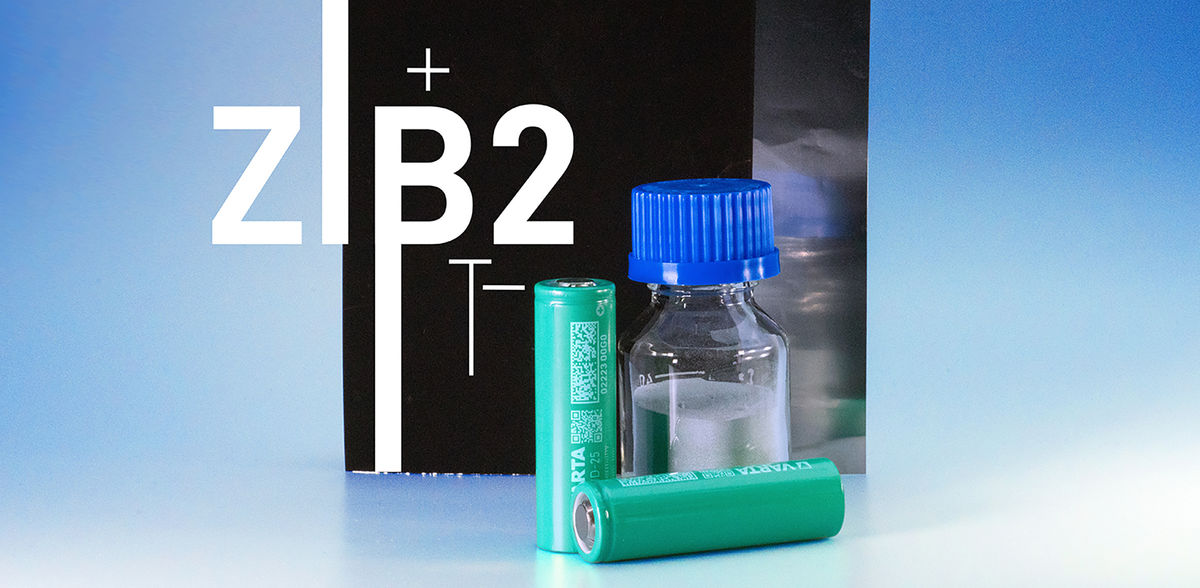Sustainable zinc-ion batteries for the energy transition
Research project aims for rapid industrial implementation
Advertisement
Stationary energy storage systems aiming to relieve the public power grid during peak loads play an important role in the implementation the energy transition. zinc-ion batteries have been the focus of attention for these and other applications for some time - but so far without commercial success. The BMBF-funded research project "Aqueous Zinc-Ion batteries ZIB2" is now investigating how an industrial implementation can be successful. The use of non-critical, low-cost materials, an increase in efficiency and extension of cycle life as well as the application of industrial cell designs are the central scientific goals of the project.
Aqueous zinc-ion batteries (ZIB) are often referred to as a green energy storage technology because their cell chemistry is based on sufficiently available zinc. The batteries are considered safe to operate, environmentally friendly and economical. Additionally, there is no risk of explosion or fire because water is an essential component of the cell. Although ZIB systems have already reached a high level of technological maturity, the technology has not yet been able to establish itself across broad fields of application compared to the lithium-ion battery (LIB). However, as the demand for sustainable storage technologies continues to grow, alternative systems such as ZIB are increasingly coming into focus. The market launch of zinc-ion technology is being accelerated by the steadily increasing demand for energy storage, the growing shortage of raw materials for established systems, and the desire for greater environmental friendliness and sustainability. Thus, ZIB are changing into a real alternative to the dominant LIB technology, especially in the field of stationary storage.
State-of-the-art and technical challenges of zinc-ion batteries
On the one hand modern zinc ion concepts consist, of a positive electrode with a variety of possible materials such as manganese oxides, vanadium oxides or Prussian blue analogs (PBA) such as copper hexacyanoferrate and, on the other hand, of a negative electrode made of metallic zinc. This is complemented by the use of water as the electrolyte, which immensely increases the intrinsic safety of the ZIB system.
Cost efficiency, economy, safety and sustainability are nowadays the driving forces when it comes to choosing a suitable battery storage system for stationary applications, such as storing surplus solar or wind energy. Unlike established technologies, such as LIB, aqueous zinc-ion systems fully meet the above critical market requirements. Thanks to their high environmental friendliness, the aqueous, non-toxic electrolytes and materials used, the high specific power essential for power grid applications, and the low cost due to the good availability of zinc, ZIBs represent an attractive approach to solving the current and future energy storage problem.
The PBA cathode materials addressed in ZIB2 are characterized by their low energy losses and their ability to charge and discharge fast. This makes them particularly relevant for applications in the stationary energy storage sector, where it is necessary to react quickly to any peak loads in the power grid in order to avoid widespread power outages. Another advantage of PBA cathode materials is their simple, scalable and cost-effective synthesis. In the course of rapid commercialization, large quantities of electrodes can thus be produced and further processed into numerous cells according to the demand. A major disadvantage of PBA systems has been their short lifetime of only 300 cycles (charge and discharge). However, project partners of the ZIB2 consortium have already been able to increase the lifetime of PBA-based ZIBs to 800 cycles by cleverly modifying the respective PBA structure. Additional strategies are being pursued in the current project to increase the performance of the ZIB technology and thus enable rapid use of the developed cells in real application scenarios.
Improved cycle life and efficiency due to innovative materials and cell concepts
To further increase the lifetime and efficiency of zinc-ion batteries, the project partners are synthesizing, characterizing and optimizing novel materials, both for the anode and the cathode. In addition, new electrolyte compositions are being produced and studied in detail. Furthermore, the aging mechanisms occurring at the electrodes, which can impair the long cycle life of the battery cells, will be identified and analyzed. This will provide clues for further optimization of the interaction between the electrodes and the electrolyte. After the identification of promising materials and material combinations, various industry-oriented cell designs will be developed, produced and tested in order to determine the optimal design for a final, production-ready product. Different manufacturing processes will also be addressed, like printing of ZIBs. Finally, all starting materials, cell components and manufacturing processes will be subjected to a detailed economic and ecological evaluation in order to determine the full market potential of this novel battery technology and to prove the economic viability and environmental friendliness of the ZIB system.
Other news from the department business & finance
Most read news
More news from our other portals
See the theme worlds for related content
Topic World Battery Technology
The topic world Battery Technology combines relevant knowledge in a unique way. Here you will find everything about suppliers and their products, webinars, white papers, catalogs and brochures.

Topic World Battery Technology
The topic world Battery Technology combines relevant knowledge in a unique way. Here you will find everything about suppliers and their products, webinars, white papers, catalogs and brochures.





























































